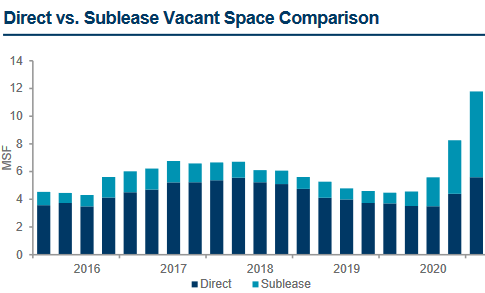How Fast Can a “Shortage” of Office Space Turn into a “Glut?” San Francisco Shows How Fast
by Wolf Richter, Wolf Street:
 Commercial real estate is in turmoil, but San Francisco’s glut is dwarfed by the fiascos in Houston and Calgary.
Commercial real estate is in turmoil, but San Francisco’s glut is dwarfed by the fiascos in Houston and Calgary.
During the Good Times, when there was still a “shortage” of office space in hot markets, such as in San Francisco, companies resorted to warehousing of office space. They leased office space they didn’t need, and wouldn’t need for years, because they didn’t want their expected growth, and the expected growth in staffing, to be crimped by the shortage of office space.
They grabbed all available office space and leased it long-term, expecting to grow into the space in future years, thereby creating an artificial shortage.
Tech and social media companies and richly funded startups are infamous for that. And since money is no objective for these companies when they’re in rampant growth mode, or when they’re trying to be in rampant growth mode though they might not yet have much in terms of revenues or growth, it’s OK to blow money on vacant office space – until suddenly it isn’t.
As these leased offices sat around vacant, waiting for things to happen, suddenly things happened. The Pandemic put work-from-home on the map, and companies figured out how to manage it, and how at least some of their current and future staff would be working remotely, thereby shifting office expenses, including rent, from the company to households.
And they figured out how to implement more radical versions of this permanently, and suddenly all this vacant office space that they leased and were planning to stuff people into in future years seemed superfluous and expensive, and since they were locked into long-term leases that they can’t get out of, they put this office space on the market as subleases.
For example, Twitter leases its headquarters building in San Francisco from the Shorenstein Company, which owns the building. Now Twitter has switched to a permanent hybrid work-from-home approach – some employees will still need to go to the office, but others won’t. And it no longer expects to fill the empty space that it has been warehousing.
In September, it put over 100,000 square feet of its office space on the sublease market, hoping to get some rent out of this thing. Twitter doesn’t have to break even, just get some rent to cover some of its costs – and it would be way ahead. And so Twitter, along with the other companies putting office space on the sublease market, can undercut the market and put downward pressure on the rest of the market.
This is how an office shortage turns into an office glut – when this large amount of warehoused office space, that was vacant but wasn’t considered inventory for lease, suddenly becomes inventory for lease.
This chart from Cushman & Wakefield’s Q3 MarketBeat Report on San Francisco shows the surge in availability of sublease space in Q2 and Q3 (light blue), even as space offered directly by landlords has risen only moderately (dark blue). Overall vacancy rate has surged by 8.6 percentage points from Q3 last year to 14.1% at the end of September, driven by the sudden appearance of 6.18 million square feet (msf) of sublease space (chart via Cushman & Wakefield):

“This increase in vacancy can be found in all submarkets and size segments from large blocks of 50,000 sf or more down to partial floor tenants,” Cushman & Wakefield said.
While a total vacancy rate of 14.1%, after years of an artificial office space “shortage,” is rattling some nerves, it pales in comparison to the fiasco playing out in Houston.
Houston’s office-market fiasco, by far the worst in the US, started in 2014 with the oil bust that coincided with a Texas-sized office construction boom that drove vacancy rates above 20% years ago. And now, the situation was made worse by the trend to working-from-home. Data according to Cushman & Wakefield’s Q3 MarketBeat report for Houston:



